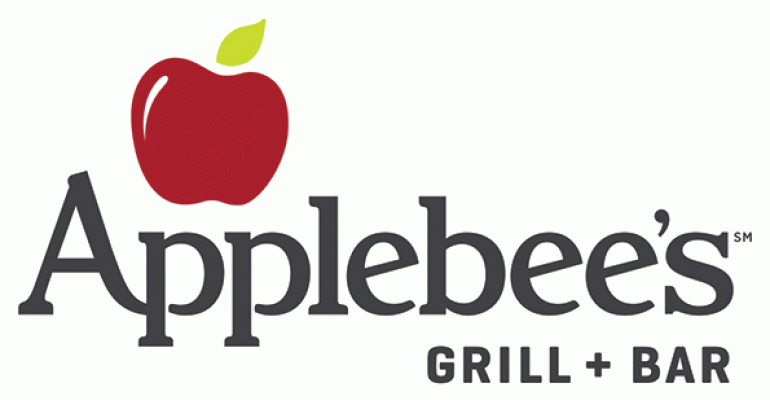Revitalization efforts at Applebee’s have not yet moved the needle in driving short-term results, but executives said Wednesday that changing the casual-dining brand’s story will take time.
Glendale, Calif.-based parent company DineEquity Inc. said domestic systemwide same-store sales for Applebee’s declined 4.2 percent during the June 30-ended second quarter, despite the launch of a comprehensive menu overhaul in May that included hand-cut steaks cooked over wood-fired grills.
Domestic systemwide same-store sales increased 0.2 percent for sister brand IHOP, but those results were also disappointing, said Julia Stewart, DineEquity chairman and CEO.
As a result, the company downgraded its guidance for the year, saying Applebee’s same-store sales would likely range between negative 3 percent to negative 4.5 percent, compared with previous expectations of same-store sales that would range between down 2 percent to an increase of 2 percent.
Expectations for IHOP same-store sales for the year were revised to range between increases of 0.5 percent to 2 percent, compared with earlier projections of a 1-percent to 4-percent increase.
Applebee’s rolled out the new wood-fired grill platform midway through the second quarter with TV advertising that focused on hand-cut steaks and new wood-fired grills installed in all restaurants. About 40 percent of the menu is now cooked over oak.
Stewart said the response to the new menu has been good, according to proprietary research, with 90 percent of customers who ordered grilled items saying they would order them again.
But she said the chain did not do enough to communicate value in its marketing of the launch. Some consumers saw ads for the new steaks and may have assumed they were expensive, she said, although most steaks on the menu fall between the “everyday value” price of about $12.99 to $14.99.
“It’s less about the price that franchisees are actually charging for it,” said Stewart. “It’s the fact that we didn’t put the price on television.”
For the latter half of the year, marketing efforts will focus more on value, but also other non-beef grilled items on the menu, and grilled proteins on salads.
Stewart said Applebee’s is seeing higher satisfaction scores on internal surveys for service, and 64 percent of restaurants are internally graded either A or B operationally.
The brand has done a good job of attracting Millennials, she said, doubling the percentage of that demographic in the last four years. More than 40 percent of Applebee’s customers are Millennials.
Revitalization efforts are continuing, with moves to upgrade the bar, improve the carside-to-go business, and a remodel and new restaurant design in the works, as well as leveraging digital and social media to interact more directly with customers in real time, said Stewart.
“This is just the start of changing the Applebee’s story, which takes time,” she said.
IHOP’s disappointing same-store sales were impacted in part by changing consumer sentiment during the quarter that caused customers to be “more conservative and value driven,” said Stewart.
About 350 IHOP locations are on track to be remodeled this year, and the chain is placing greater emphasis on food, with a fresh, made-to-order menu and use of fresh ingredients, which Stewart contended sets the brand apart from the increasingly breakfast-focused fast-food world.
IHOP also needs to better communicate value, she said. This month the chain is offering a Kids Eat Free at dinner promotion.
Though the breakfast space has become more competitive, she said, IHOP will continue to focus on its breakfast-all-day specialty and brand differentiation.
DineEquity hired a new ad agency, Campbell Ewald, part of the Interpublic Group, which is expected to launch a bold, new marketing campaign in September. That campaign will also include targeted messaging to Hispanic consumers.
DineEquity net income was $26.8 million in the second quarter, or $1.45 per share, compared with $26.9 million, or $1.40 per share, a year ago, in part because of charges related to the consolidation of the two brand headquarters in Glendale, Calif., which was offset by lower taxes, higher gross profit and a decline in interest expense.
Adjusted net income was $28.8 million, or $1.59 per share, compared with $28.9 million, or $1.53 per share, a year ago.
Revenue was $160.3 million, falling from $171.5 million a year ago.
DineEquity also said franchisees are expected to open fewer Applebee’s units than previously projected this year.
Between 25 and 30 new restaurants are expected to open in fiscal 2016, compared with earlier projections of between 35 and 45 new units. Applebee’s, a fully franchised brand, ended the quarter with 2,028 units.
IHOP franchisees, meanwhile, are expected to open more of the family-dining restaurants.
This year, the company expects IHOP franchisees and area licensees to develop between 65 and 77 new restaurants, compared with the 60 to 70 expected earlier.
IHOP, which is nearly fully franchised, ended the quarter with 1,686 locations.
Contact Lisa Jennings at [email protected]
Follow her on Twitter: @livetodineout





